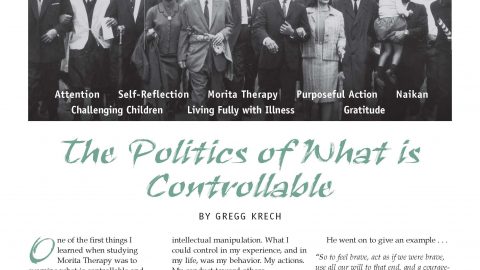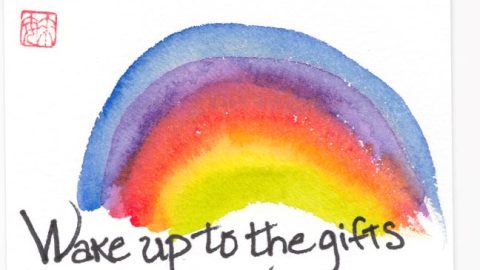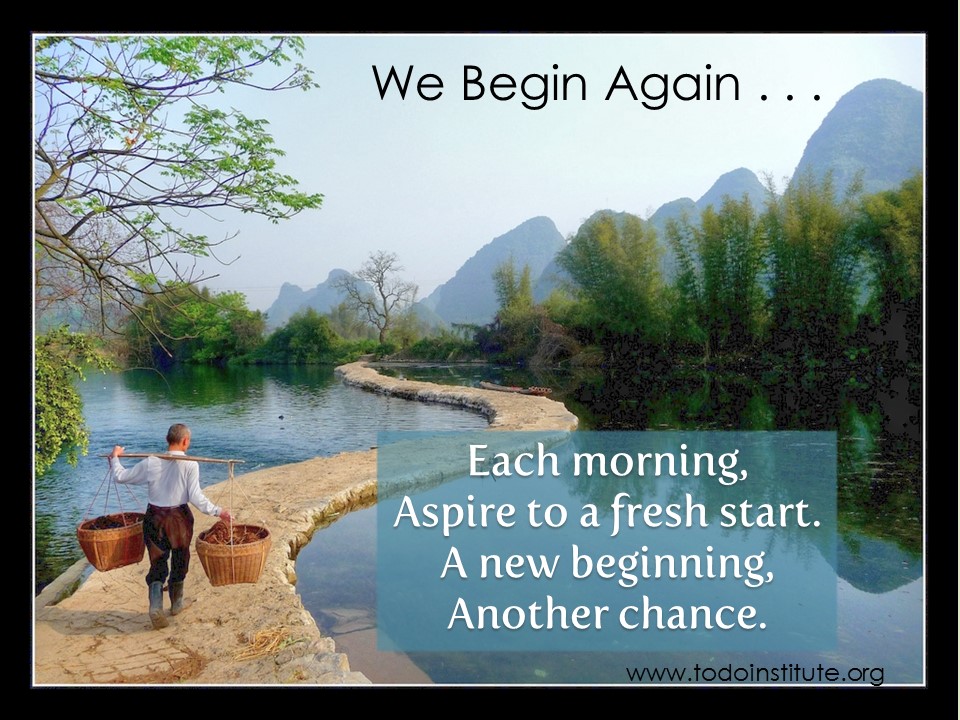“Purpose-mindedness helps mood-governed clients to pay more attention to their action and the environment, instead of incessantly dwelling on feelings.”
— F. Ishu Ishiyama, Ph.D.
In Vermont we have a fifth season called “Mud Season.” It happens between early March and late April when the ground thaws and the snow melts. The fast-melting snow, encouraged by Spring rains, easily overwhelms the slow-thawing earth, creating a queue for drainage much worse than the lines at the Motor Vehicle Department. Since many of us rural Vermonters live on dirt roads with dirt driveways, we experience mud in its full glory. And we experience getting stuck in its full glory as well.
There’s a story about a young man who got his pickup truck stranded in deep mud on a back road. Not wanting to spend the money on a tow truck, he got his friend to come by with his own pickup truck and some chains to try to pull him out. But when you’ve been stuck in the mud, you learn that mud actually creates suction and the young man’s pickup truck wouldn’t budge an inch. So the rescue truck kept gunning the engine with more and more power. Unfortunately, they hadn’t been quite careful enough about where they attached the chains on the stranded truck and suddenly there was a loud crack and a jolt and the young man’s lower jaw dropped as he saw much of the front section of the truck separate from the chassis. All four tires, meanwhile, remained firmly buried in the unrelenting mud. That’s what it means to be stuck!
Perhaps you’ve experienced something similar. You want to move forward on something, but your wishes and desires don’t seem to stimulate any action. You just remain in the same place – day after day, month after month. This happens to most of us at one time or another. It may be related to diet/exercise, finding a new job, getting into/out of a relationship, having children, writing a book, finances, etc. . . Usually getting stuck involves a set of feelings which acts like mud locked around our wheels. Such feelings include confusion, boredom, fear, anxiety, depression, dislike of the task, or laziness.
When we find that we’re stuck, we’re faced with the challenge of getting unstuck and taking action. Morita Therapy and Naikan are two methods of Japanese psychology which offer specific methods and strategies for getting out of the mud. Morita therapy was developed by Japanese psychiatrist Shoma Morita (1874-1938) and has a clear “action” orientation. Naikan, developed by Ishin Yoshimoto (1916-1988) is more reflective, but can also stimulate action by revealing to us a new perspective on the situation and what needs to be done.
Here are seven strategies that might help you take action the next time you find yourself stuck:
1. Acceptance (Arugamama)
Arugamama is a Japanese word that means “to accept things as they are.” We may think of acceptance as passive, but it is really the first step to taking action. We need to look clearly at our situation and accept the reality of that situation. Perhaps we are in a great deal of financial trouble, but rather than accept the reality of the situation we fool ourselves into thinking that our situation isn’t so bad. “Lots of people have credit card debt,” we say to ourselves. We “think positively” while we buy a dozen lottery tickets at the corner store and pray that we will be saved by a winning ticket.
Too often we avoid looking honestly at the reality of our circumstances, particularly when an honest look would give us some unpleasant information to accept. Our pants are getting tighter and tighter, but we avoid getting on the scale to see our true weight. Our child is continually getting into trouble at school and is getting failing grades, but we shrug it off by saying “Oh, it’s just a phase all boys go through at that age.” It’s difficult to take action (particularly appropriate action) if we don’t see and accept the truth of our situation. So step back from the situation and try to see the facts clearly just the facts, not your feelings about the situation or your analysis of it. Just notice the reality of your circumstances as clearly and honestly as possible. This may not be pleasant, but once you have accepted “reality as it is,” you have overcome a major obstacle to taking action.
2. Clarify Your Purpose
According to Morita, our healthy desires for accomplishment are often accompanied by fears and anxiety. This is a natural aspect of human nature. A woman may hope to receive a promotion at work and she is excited when she hears of her promotion. At the same time, she suddenly notices moments of fear and anxiety. What if she doesn’t succeed? What is people discover her weaknesses and limitations? If we accept and co-exist with these thoughts and feelings, then we can continue to take action towards our goals and healthy desires for a good life. But if our attention is trapped by our thoughts and feelings of fear and anxiety, we begin to forget about our goals and redirect our energy towards escape from our psychological discomfort. In essence, we lose our original purpose of accomplishment and substitute a new purpose which is to escape from discomfort.
So when you find yourself stuck it is a good idea to remind yourself of your original purpose. You might even take a few minutes and write a statement of purpose. If you are procrastinating on a project, we consider posting your purpose statement on the bathroom mirror or the computer monitor. By clarifying your purpose(s) you can more easily redirect your energy and attention – away from symptoms (e.g. fear and anxiety) and towards appropriate action to meet the needs of the situation.
3. Reflect on How Not Taking Action May Cause Trouble to Others
Much of what has been said so far originates in Morita therapy, but let’s switch gears for a moment to another method from Japan called Naikan. Naikan is a method of self-reflection and, initially, may not seem like it would offer much to those who are stuck. The three questions that are the essence of Naikan are:
A. What have I received from others?
B. What have I given to others?
C. What troubles and difficulties have I caused others?
Yoshimoto Ishin, who developed Naikan self-reflection, suggested we place the greatest emphasis on the third question. This question asks us to put ourselves in another person’s shoes. If I am late in completing a particular project, I am probably very familiar with the events and circumstances that resulted in my tardiness. I may feel frustrated about my circumstances or upset about incidents that happened earlier that week. I may offer a polite apology when I finally submit my finished work, but my attention is mostly on my own difficulties, stresses and life challenges. If so, little attention is really available to consider how I have inconvenienced others. What effects, specifically, has my procrastination had on others? Who was inconvenienced and how? When I am late with something (which happens too often) I try to think about the person/people who are waiting. What inconvenience am I causing? How will this effect their work? What is it like to be “them” and have to wait for “me”? In many cases, this makes me feel worse about being late. But it often stimulates me to take action as I realize the consequences of my inaction on the lives and welfare of others.
4. Take Small Steps
Years ago I had a student who had failed to file tax returns for three years in a row. He was at the point where he was facing some serious consequences from the IRS. He also claimed to be in a constant state of stress and anxiety about his situation. The only way out was to assemble the records needed to complete each year’s tax return. But his financial records and receipts were completely disorganized and sitting in multiple boxes in his basement. He had been ruminating about his situation for months, but he had taken no action. This was his personal mud season.
This situation felt overwhelming, but I suggested that he simply tackle the project one step at a time and just focus on the most immediate step. The first step was to request blank tax forms for those years, so that became his task. It was fairly easy – just involving a single call to the IRS. Still, just dialing the IRS’s number stimulated incredible anxiety for him. Yet he learned he could co-exist with his anxiety while calling. The next step was to sort through his boxes of financial records. Rather than attempt to finish a box in one sitting, he simply sorted a “handful” of papers and then stopped. It took him a while, but eventually he had sorted the records by type and by year. After a number of months he finally had completed and mailed all his tax returns. He paid handsomely for his lateness, but he got everything resolved and finally, after many years, he experienced the relief of conquering this particular demon of inaction. He took a large, confusing and challenging project that seemed overwhelming and impossible and turned it into a series of small, manageable and achievable steps.
5. Make an Appointment
An appointment allows you to be clear about where you’re supposed to be and what you’re supposed to do at a specific time. Appointments provide clarity. If you have an appointment to meet Martha for lunch you know where you’re supposed to be at 12:30pm on Tuesday and what you should be doing. Usually, you don’t have an internal dialogue at 12:15pm in which your mind says, “Maybe instead of eating lunch with Martha I should call Lisa and do some gardening with her instead.”
You can use appointments as a tool for anything. You can make an appointment to exercise, to work on your taxes, to write your novel, to practice the piano . . . just about anything that you need to do and aren’t doing. Just write it in your appointment book and treat it like a “real” appointment. Don’t be late, and don’t cancel unless there’s a serious emergency that requires your attention. Have a starting and ending time. Be rigid about your starting time but give yourself the flexibility of going past the ending time. Appointments work well if you keep them. And you may find that once you’re engaged with whatever you made an appointment to do, you find it somewhat interesting and get some momentum for the next time.
6. Give up (for a while)
So now you’ve tried everything. You’ve read this article, you’ve read every book on procrastination, you’ve gone to therapy for the past year, you’ve recited affirmations, you’ve talked to all your friends, you’ve visualized and been hypnotized. Nothing has worked. You’re still stuck. My advice to you is, well . . . . give up!
Abandon your dream, your goal, your project. If you’ve tried so many things and you’re firmly stuck in the same place you were x months ago, maybe what you want to do just isn’t so important. Maybe you should just accept a life in which you won’t write a novel, or find a new career, or learn to play the piano. Just think of how much time you’ve spent reading and talking and visualizing and how much you could have done if you would have used that time to simply take action on what you want to do. So I honestly think it’s reasonable to give up at this point at least for a while. Take a month off from your quest or three months. Leave your truck stuck in the mud for the time being and stop trying to get it out. There may be consequences you’ll have to accept, but you’ll free up all the time you spend reading, talking and affirming. And you can use that time for something meaningful. See what it’s like to live for a while without trying to get un-stuck.
I don’t generally advise people to quit, but there’s a trap in “trying.” You mistake preparation for action. Meanwhile, while you’re doing other things, life will continue its process of change. After mud season, the ground hardens and the mud disappears. Sometimes its easier to dig yourself out in the summer.
But if you’re willing to make a sincere effort, and to work hard, and you’re persistent, and you follow the advice I’ve offered in the first six items then there’s a good chance that you’ll find yourself driving away from the place you were stuck. Your clothes may be dirty and torn, your face may be splashed with mud, and your body may feel exhausted. But you’ll be stronger for the effort and you may learn something about mud and trucks and life. And as you drive away, you can ponder the question, “Who liberated me from that predicament?” And then you know that you’re headed in the right direction.
Gregg Krech will be offering his annual TAKING ACTION PROGRAM, beginning on Feb . 19, 2024. Address issues such as productivity and procrastination, while working on a special project of your own choice. Gregg is the author of 5 books, including the Amazon best-seller, The Art of Taking Action: Lessons from Japanese Psychology.
Tags: All Members









